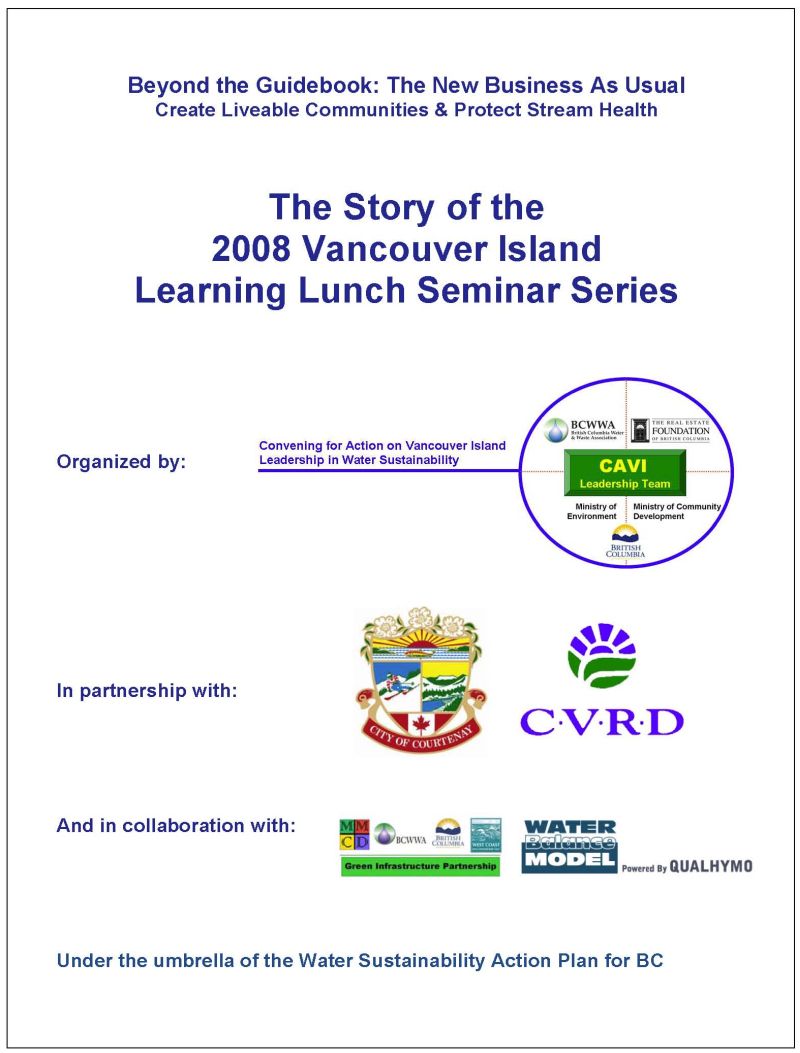FLASHBACK TO 2008: Capacity-building program branded as the “Vancouver Island Learning Lunch Seminar Series” – and implemented in the Comox and Cowichan valleys – was a demonstration application of how to build inter-departmental and inter-governmental alignment to achieve the vision for Living Water Smart, BC’s Water Plan
Note to Reader:
In June 2008, Comox Valley local governments embraced an invitation to be a demonstration region for a regional team approach to collaboration, guided by this Living Water Smart lynch-pin target for watershed health:
“All land and water managers will know what makes a stream healthy, and therefore be able to help land and water users factor in new approaches to securing stream health and the full range of stream benefits.” (Reference: page 43)
Provincial intervention and regional district restructuring spurred inter-governmental cooperation in the Comox Valley. Provincial action:
- created the Comox Valley Regional District;
- mandated development of a Comox Valley Regional Growth Strategy and a Regional Water Supply Plan; and
- resulted in implementation of the CAVI-Convening for Action on Vancouver Island program for peer-based learning and sharing.
As part of the Living Water Smart roll-out, seminar programs were implemented in both the Comox Valley and the Cowichan Valley. Download a copy of the The Story of the 2008 Vancouver Island Learning Lunch Seminar Series,



Desired Outcome: All Land and Water Managers will Know What Makes a Stream Healthy
Released in June 2008, “Living Water Smart, British Columbia’s Water Plan” was the Province’s call to action create greener communities and prepare for climate change. To this day, Living Water Smart transcends governments. The ripple effects resulting from transformational initiatives inspired by Living Water Smart are reverberating through time.
Look back to look forward. What have we learned? How do we pass that understanding (of what we have learned over the past 10 years) onto successive generations of land use, infrastructure and asset management professionals who do their work in the local government setting? How can we help them make informed choices that benefit from past experience?
A decade later, these are just some of the questions that guide the work of the Partnership for Water Sustainability in British Columbia.
Living Water Smart, British Columbia’s Water Plan
 “While legislative reform is a foundation piece, collaboration takes place outside the legislative framework,” Lynn Kriwoken stated in 2008. An Executive Director in the Ministry of Environment and Climate Change, she personifies continuity, commitment and leadership in bringing the Living Water Smart vision to fruition.
“While legislative reform is a foundation piece, collaboration takes place outside the legislative framework,” Lynn Kriwoken stated in 2008. An Executive Director in the Ministry of Environment and Climate Change, she personifies continuity, commitment and leadership in bringing the Living Water Smart vision to fruition.
“This is why we constantly emphasize that Living Water Smart is about motivating and inspiring everyone to embrace shared responsibility. Influencing behaviour and attitudes is at the heart of moving from awareness to action,” added Kriwoken.
The New Business As Usual
Looking back, launch of the Living Water Smart outreach program commenced with a precedent-setting approach to capacity-building in the local government sector.
Known as the 2008 Vancouver Island Learning Lunch Seminar Series, and delivered through the CAVI-Convening for Action on Vancouver Island initiative, this capacity-building program was a “grass-roots” demonstration application of how to build inter-departmental and inter-governmental alignment.
 “We are using the slogan The New Business As Usual to convey the message that, for change to really occur, practices that until now have been viewed as the exception must become the norm moving forward. We have to build regulatory models and develop models of practice and expertise to support The New Business As Usual,” stated Dale Wall, former Deputy Minister in the Ministry of Community Development when he announced the Vancouver Island Learning Lunch Seminar Series at the Gaining Ground Summit.
“We are using the slogan The New Business As Usual to convey the message that, for change to really occur, practices that until now have been viewed as the exception must become the norm moving forward. We have to build regulatory models and develop models of practice and expertise to support The New Business As Usual,” stated Dale Wall, former Deputy Minister in the Ministry of Community Development when he announced the Vancouver Island Learning Lunch Seminar Series at the Gaining Ground Summit.
Vancouver Island Demonstration Applications
 “Both the Cowichan Valley Regional District and City of Courtenay stepped up to the plate and volunteered to host a regional seminar series. More than a decade later, the Partnership for Water Sustainability continues to celebrate Cowichan Valey and Comox Valley leadership as early adopters,” states Kim Stephens, Partnership Executive Director.
“Both the Cowichan Valley Regional District and City of Courtenay stepped up to the plate and volunteered to host a regional seminar series. More than a decade later, the Partnership for Water Sustainability continues to celebrate Cowichan Valey and Comox Valley leadership as early adopters,” states Kim Stephens, Partnership Executive Director.
“When reflecting on what their efforts set in motion, and what comes next in the capacity-building process, there is a direct line from Comox Valley and Cowichan Valley pioneering efforts in 2008 and the current Vancouver Island Symposia Series: Water Stewardship in a Changing Climate.”
First, the Cowichan Valley Series in June-July 2008
 “Each session in the Cowichan Valley Learning Lunch Seminar Series started at 11:00am and ended at 2:30pm,” stated Peter Nilsen, former Deputy Engineer with the District of North Cowichan.
“Each session in the Cowichan Valley Learning Lunch Seminar Series started at 11:00am and ended at 2:30pm,” stated Peter Nilsen, former Deputy Engineer with the District of North Cowichan.
“This was the right length of time to maintain the interest and energy level of participants. Three and a half hours sounds like a lot of time, but it goes quickly; and we were just scratching the surface in terms of the material that we presented.”
 Inter-departmental participation by all member local governments effectively meant closing front counters on three Fridays for most of the day so that planning, engineering, operations and building inspection staff could attend the Learning Lunch seminars.
Inter-departmental participation by all member local governments effectively meant closing front counters on three Fridays for most of the day so that planning, engineering, operations and building inspection staff could attend the Learning Lunch seminars.
“Throughout the series, our theme and our challenge was to ask participants what will they do better or differently to achieve a shared vision for the Cowichan Valley,” stated David Hewetson, Building Inspector with the City of Duncan. “This is why it was so important to get everyone thinking in terms of the What – So What – Now What mind-map.”

Kevin Lagan, City of Courtenay Director of Engineering, leads a walkabout at Seminar #1
Then, the Comox Valley as a monthly series in September, October and November 2008
The Comox Valley series benefited from the insights that were gained from the successful Busy Place Creek walkabout, which was the finale for the Cowichan Valley series.
 “Walkabouts facilitate conversations and on-the-ground learning. This approach proved especially successful when we hosted the Showcasing Innovation series,” stated Kevin Lagan, former Director of Operational Services with the City of Courtenay. “We decided to feature the east Courtenay area in Seminar #1 because this part of the city has evolved from fields and forest over the past two decades, and so has our approach to rainwater / stormwater management. “Placing the spotlight on the east Courtenay area helped seminar participants understand why drainage practices comprise a continuum of paradigms.
“Walkabouts facilitate conversations and on-the-ground learning. This approach proved especially successful when we hosted the Showcasing Innovation series,” stated Kevin Lagan, former Director of Operational Services with the City of Courtenay. “We decided to feature the east Courtenay area in Seminar #1 because this part of the city has evolved from fields and forest over the past two decades, and so has our approach to rainwater / stormwater management. “Placing the spotlight on the east Courtenay area helped seminar participants understand why drainage practices comprise a continuum of paradigms.
 “By placing the spotlight on the east Courtenay area, this helped seminar participants understand why drainage practices comprise a continuum of paradigms, and communities progress at different rates along the continuum,” added Derek Richmond, the City’s former Manager of Engineering .
“By placing the spotlight on the east Courtenay area, this helped seminar participants understand why drainage practices comprise a continuum of paradigms, and communities progress at different rates along the continuum,” added Derek Richmond, the City’s former Manager of Engineering .
“In the first seminar, the theme was evolution. After that, the focus was on tools, in particular legal and policy strategies that will help implement the New Business As Usual. Finally, the third seminar looked at how all the elements of regional needs fit together.
“In concluding the series, participants explored a regional team approach that would ensure consistency in doing business differently to create liveable communities and protect stream health.”
High-Level Endorsement:
H igh-level endorsement for a ‘regional team approach’ was provided when Mayors and Chief Administrative Officers representing the four Comox Valley local governments dropped in to show their support for the Learning Lunch Seminar Series.
igh-level endorsement for a ‘regional team approach’ was provided when Mayors and Chief Administrative Officers representing the four Comox Valley local governments dropped in to show their support for the Learning Lunch Seminar Series.
Sandy Gray, City of Courtenay CAO, lauded the objectives of the Learning Lunch Seminar Series. “We are thrilled by the work of CAVI. It is a tremendous initiative,” he said. “The cooperation that is taking place around a consistent approach to development is very critical to all of Vancouver Island.”
To Learn More:
Visit the homepage for the 2008 Cowichan Valley Learning Lunch Seminar Series.
Visit the homepage for the 2008 Comox Valley Learning Lunch Seminar Series.
Visit the homepage for the 2008 Cowichan Valley Water Balance Forum.

Walkabout at Comox Valley Seminar #1 (September 2008)

Group discussion at Comox Valley Seminar #3 (November 2008)

Breakout groups at Cowichan Valley Learning Lunch Seminar #1 – June 2008


